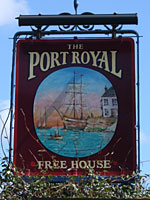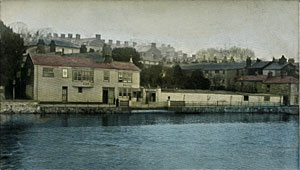
The Port Royal Inn, Exeter Quay
Page updated 2 July 2009
 In 1823, the wife
of the landlord of the Fountain Inn (Prospect Inn) was found in the Exe
at Salmon Pool. She was taken to The Exeter Humane Society, near the
Lime Kilns, but attempts to revive her failed - it is probable that
this was one of the buildings that became the Port Royal.
In 1823, the wife
of the landlord of the Fountain Inn (Prospect Inn) was found in the Exe
at Salmon Pool. She was taken to The Exeter Humane Society, near the
Lime Kilns, but attempts to revive her failed - it is probable that
this was one of the buildings that became the Port Royal.
It is not certain when the Port Royal first traded but the earliest date I have found appears in the 1844 copy of Pigot's Directory of Exeter, where Robert Ugler is listed as the landlord of the Port Royal Tavern. Ugler's rein as innkeeper was short lived, for in 1850 George Webber was running the Port Royal at St Leonard's Quay. Five years on and the 1855 Exeter Journal & Almanack, listed one John Western as the landlord of the Port Royal on the Quay.
Sixty-Six Years a landlord
The 1857 Billings Directory of Devon lists Charles Edwards as the landlord of the Port Royal Public House, Lime Kiln. He was 26 years old, and the son of the ferry man at the quay. Edwards' married Susan in 1861 and they had a daughter, Alice. Edwards' is listed as running a 'passage-boat' on the quay, and also as a boat builder.
Edwards' mother continued to run the ferry after her husband's death. She died in June 1877, so Charles Edwards wrote to the Council offering to continue renting the ferry at the same rate as his late mother, at £100 per year. The Committee resolved to advertise the lease and in January 1878, it was offered for seven years from Lady-Day next. It is not known who the next ferry man was.
Maude Alice Richards, from Kent ,was a personal guest of Charles Edwards, when she visited him, in September 1887. She attended the evening performance of Romany Rye at the Theatre Royal the night the theatre was burnt down. She did not escape the inferno, and her body was identified by her husband.
The last listing I have found is the Post Office directory of 1923 which still shows Charles Edwards. Charles Edwards died at the end of 1923 at the age of 93 years old, making his tenure of the Port Royal, at least 66 years.
Exeter Rowing Club
Before they moved to new premises, the Exeter Amateur Rowing Club was first established in 1864 at the Port Royal. In 1927 the Port Royal Amateur Rowing Club was formed, which was merged with the Exeter Amateur Rowing Club in 1946 to form the Exeter Rowing Club. The boat house at the Port Royal was rebuilt in 1952 by the St Anne's Well Brewery at a cost of £1,600 and opened by Mr G Pring on 6th June. The old boat-house is now the pub's restaurant.
In 1870, the employees of the Trews Weir Mill dined at the Port Royal. In the same year a soup kitchen was opened for those who were not in regular employment. Also, as was common in the 19th-century, the Port Royal was used for an inquest in 1878.
A deed of 1924 noted of the Port Royal that came "with the Brewhouse and cellar and Outbuildings, yard and Boathouse, Bagatelle room and premises thereto adjoining".
In 1930, the pub was taken over by Norman Pring. The link with rowing was maintained when a new boat house was opened in 1952. Pring sold out to Starkey, Knight and Ford in 1962. Exeter Rowing Club finally vacated their clubhouse at the pub in 1981 and in 1982 their old room was converted into a function room. Further improvement have been made and the owners claim that it is the longest pub in Exeter.
The Whirlwind
Strangely, the Port Royal was once hit by a whirlwind. On 7 September 1850, a four-oared gig moored next to the building was picked up by a sudden swirling wind and lifted some 15 ft above the river. The boat was then dropped back into the water, as amazed customers looked on.
The incident was reported in the Illustrated London News on 14 September with this statement from George Webber, the landlord:
"On Saturday afternoon last, between the hours of three and four, whilst working in his shed, his attention was arrested by a loud rushing sound, which proceeded from a path immediately outside the building. On hastening thither he saw large stones, dust, etc., taken up as in a whirlwind, from a space on the ground as large as a coach-wheel. The revolving column gradually drew towards a small punt afloat in the adjacent river and moored to a post by the bank; the boat was then lifted as high in the air as the painter would allow, and was held there by the force of the wind, spinning round like a top. The column then moved on towards a four-oared gig, moored in a similar manner; when simultaneously the punt fell and the gig was elevated precisely from the water, whilst the stern was raised about fifteen feet. The column then seemed to have expanded its strength and fell, so to speak, in water, with the noise of a ton weight, dashing and stirring up the bed of the river with foam. The gig is thirty feet long and had in her at the time such was taken up from twelve to fifteen gallons of water: she has been rendered quite useless. What renders the occurrence the more remarkable is that at the time scarcely a breath of wind was stirring, and the sky was nearly cloudless."
Source - St Leonards by Gilbert Venn, an Exeter City Guide Book from the 1920's and Exeter in Old Photographs by Peter Thomas, Two Thousand Years in Exeter by W G Hoskins, Trewman's Exeter Flying Post. The Exe Island and City Breweries by Geoffrey Pring, Illustrated London News.

The
Port Royal circa 1920.
The Port Royal from a postcard. The
many dwellings near the river suffered flooding.
The Port Royal in 1967 - photo Jim Billsborough.
The 1850 whirlwind as depicted in the Illustrated London
News.
│ Top of Page │